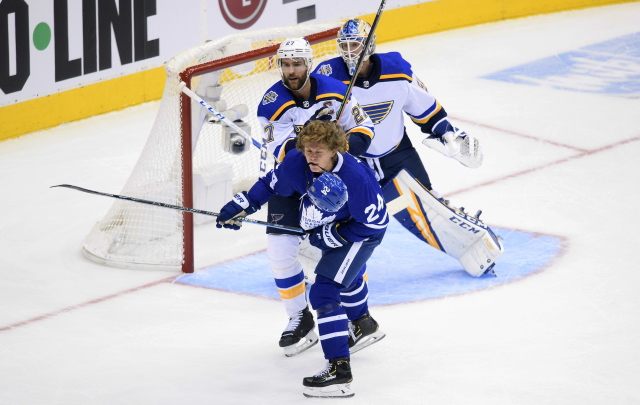The NHL’s decision to pause its 2019-20 regular-season schedule over COVID-19 concerns generated uncertainty over when the league will return to action. The best-case scenario is May 15, allowing sufficient time to finish the schedule and stage full playoff rounds.
It’s also possible the league will be forced to scrap the remainder of the regular season for a truncated postseason schedule or scrap the entire campaign. Given the potential blow to its revenue, the NHL hopes to avoid that situation.
Because the salary cap is tied to league revenue, scrapping the season would result in a much lower cap than the earlier projection of between $84 million to $88 million. There’s speculation it could fall below the current $81.5 million, which would be disastrous for clubs with limited cap space for 2020-21.
The NHL and the NHL Players Association probably won’t allow that to happen. The Athletic’s Pierre LeBrun believes they could agree to an artificial cap for ’20-’21, citing a source claiming it could be done if both sides consider it the best course of action.
There’s a precedent for this. Following the 2012-13 lockout, both sides agreed to maintain the cap at the 2011-12 level ($64.5 million) for 2013-14. They could do the same with the current cap for 2020-21.
That, however, will still have consequences for the cap-strapped clubs. Here’s a look at those that will feel the pinch the most.
Arizona Coyotes
With over $79 million invested in 16 players next season, they have little wiggle room to re-sign free-agents such as Taylor Hall, Carl Soderberg, and Vinnie Hinostroza. They can gain some relief by placing permanently sidelined winger Marian Hossa ($5.275 million) on long-term injury reserve, but it won’t leave enough to re-sign everyone.
Carolina Hurricanes
Justin Williams, Sami Vatanen, Joel Edmundson and Trevor van Riemsdyk are UFAs and probably won’t be back. Carrying over $72 million tied up in 15 players, there’s not much to re-sign everyone. It could force Hurricanes general manager Don Waddell to pursue more affordable free agents or perhaps a salary-dumping trade.
Chicago Blackhawks
It seems the Blackhawks always squeezed for cap room. They have over $73 million invested in 17 players, with goaltender Corey Crawford an unrestricted free agent while restricted free agents include forwards Dominik Kubalik, Dylan Strome and Drake Caggiula. Assuming they keep Crawford in the fold, there won’t be enough for the others unless a cost-cutting deal is made. Winger Brandon Saad ($6 million) could once again become a cap casualty.
Columbus Blue Jackets
Things could get interesting for the Jackets. They’ve got over $68 million invested in 16 players, with center Pierre-Luc Dubois, winger Josh Anderson and goalies Elvis Merzlikins and Joonas Korpisalo as restricted free agents. Dubois lacks arbitration rights, but even a cost-effective bridge deal could push payroll to over $73 million. Anderson, Merzlikins, and Korpisalo have arbitration rights, meaning one of them (likely Anderson) getting could be shopped.
Edmonton Oilers
With over $70 million committed to 15 players, the Oilers will have a difficult time finding sufficient cap space for RFAs like Andreas Athanasiou and Ethan Bear. They’ll also need a reliable backup for Mikko Koskinen if they part company with Mike Smith.
New York Islanders
With restricted free agents Mathew Barzal, Ryan Pulock and Devon Toews due for raises, the Islanders ($71.3 million in 18 players) won’t have enough to re-sign them unless they free up cap space via trade or buyout. Getting those three under contract will still leave them with an ongoing need for a scoring winger for Barzal’s line.
Pittsburgh Penguins
The Penguins (over $68 million in 15 players) must decide which restricted free agent goaltender – Matt Murray or Tristan Jarry – to re-sign. Both will have arbitration rights and will seek significant raises. They must also re-sign or replace defenseman Justin Schultz and recently re-acquired winger Conor Sheary.
St. Louis Blues
With over $73 million tied up in 17 players, the defending Stanley Cup champions face difficulty re-signing captain Alex Pietrangelo. The best defenseman in this summer’s UFA market, the 28-year-old Pietrangelo could seek over $9 million annually. That’ll leave nothing to re-sign rearguard Vince Dunn and checking-line forward Sammy Blais.
Tampa Bay Lightning
A salary-dump or two could be in the works. The Bolts have 15 players taking up over $76 million, with Anthony Cirelli, Mikhail Sergachev and Erik Cernak as restricted free agents. That likely means bidding farewell to UFAs like Kevin Shattenkirk, Patrick Maroon, and Jan Rutta, but finding suitable replacements means shedding a contract or two.
Toronto Maple Leafs
The Leafs have over $76 million committed to 16 players. They’re expected to part ways with unrestricted free agent defensemen Tyson Barrie and Cody Ceci, leaving big holes on the blueline. General manager Kyle Dubas displayed considerable cap-juggling skill last summer to re-sign Mitch Marner. He’ll need more of that to bolster his defense corps, which could include swapping a forward like Kasperi Kapanen or Alexander Kerfoot for a blueliner.
Vegas Golden Knights
The Golden Knights have 14 players taking up nearly $72 million. All their core players are under contract, but they must re-sign or replace trade-deadline acquisition Robin Lehner. They could also be in the market for suitable replacements for pending UFAs Ryan Reaves, Tomas Nosek, Deryk Engelland, and Jon Merrill.
Salary info (as of March 17, 2020) via Cap Friendly.


